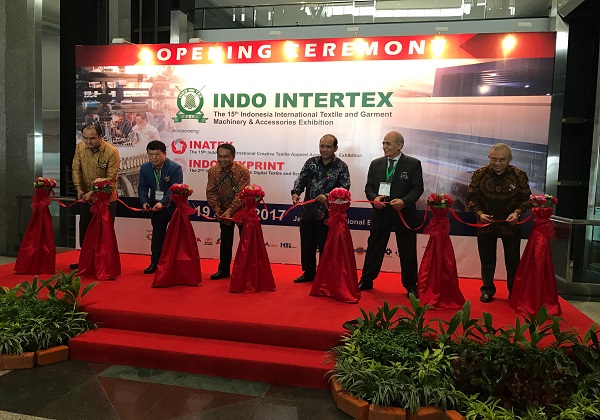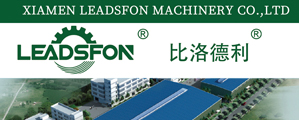INDO INTERTEX 2017 showed enormous market potential of Indonesia
May 17, 2017 | by Shen Da
The Indonesia International Garment and Textile Machinery & Accessory Expo (INDO INTERTEX) 2017, with the theme of “ Increasing Productivity through Sustainability”, has dropped the curtain for its 15th edition in Jakarta International Expo (JIEXPO) on April 19-21, 2017. Meanwhile, Indonesia International Creative Textile Apparel Accessories Exhibition (INATEX 2017) and Indonesia International Digital Textile Printing Exhibition (INDO TEXPRINT 2017) were held at the same time.
The 2017 edition played host to more than 470 international brands from 20 countries and regions as well as 8,622 visitors from all over the world in six exhibition halls, covering over 15,000 square meters.
INDO INTERTEX 2017 was a professionally enriching experience for textile and garment machinery and accessories manufacturers which included spinning, weaving, dyeing, printing, garment machineries and accessories, textile products as well as textile dyestuff and pigments, providing them an opportunity to directly market their equipment to quality buyers and decision makers in an exceeding competitive global business environment.
At present, the industry is being driven by subjects such as increasing digitalization and sustainable production processes. With the rising demands of intelligent and efficient equipment, there were various cutting-edge equipment and technology exhibited in the fair.
General situation of Indonesian textile and garment industry
The textile and garment industry is the largest tradition industry in Indonesia and its output, exports and employment scale have been ranked first in the manufacturing industry. It has formed a complete industrial chain, including artificial fiber, spinning, weaving, dyeing and printing, garments and so on, with a perfect vertical integration of upstream and downstream.
The industry is still concentrated near the capital Jakarta in the west end of Java Island, but central and eastern Java are becoming increasing important. Kevin Hartanto, SE, Secretary General of Indonesian Textile Association, said nearly 90% of textile industry in Java Island, while about 40% - 50% in the western end.
Affected by the sluggish demands of textile products in the whole world, Indonesian textile and garment industry faced a difficult environment. Kevin Hartanto, SE indicated that since 2015, the demand of the world was slowing down, some foreign companies sold products with unnormal price, which made it difficult for Indonesian enterprises to compete with foreign enterprises. But in this year, the price seemed to be normal again, so Indonesian enterprises could compete with others.
Apart from external influence, Indonesian textile enterprises still had to face difficulties from labor cost, technology and electricity.
Since 2012, there were many strikes for increasing minimum wage in Indonesia, with the result of rising 44% in Jakarta area, and about 40% in Bogor city. The wage, as one of the most important costs, accounted for about 15% to 20%, which has been a great burden to the development of textile industry. Kevin Hartanto, SE put forward that compared with Vietnam and Bangladesh, there was no advantage in labor cost. So the adjustment of basic wage has directly influenced labor-intensive industry and made it difficult to survive for small and medium-sized industry. Although there were so many labors, the skill of labors couldn’t match with the demands of enterprises. There were only one textile school to cultivate talents of textile industry. In addition, the Indonesian government would raise electricity price by stages, which made cost of production rise greatly.
Overview of Chinese exhibitors
Chinese textile enterprises showed great enthusiasm to participate in this exhibition, with the number of 248. All the Chinese exhibitors demonstrated their advanced and intelligent textile machineries, and gained good results.
At the opening ceremony, Shi Jianping, vice president of Jingwei Textile Machinery Co., Ltd. was the only person to be invited to participate in event, which showed that Chinese enterprises has got more and more attention of the world.


“Indonesia’s current population is about 240 million people, and the textile industry, as the largest traditional industry in Indonesia, plays a significant role in its national economic development. Moreover, the Indonesian government’s support for the textile industry, together with its status as an important member of China’s the Belt and Road Initiative, gives us more confidence to the broader prospects for the Indonesian market in the future.” the principal of GERON Card Clothing (Jiangsu) Co., Ltd. said.
Qingdao Haijia Machinery Co., Ltd., well known as a leading domestic manufacture of textile machinery, was founded in 1995. In the fair, Haijia Machinery exhibited HJ-412 and HJ-8100 series water jet looms. HJ-8100 series water jet loom adopts integrated design of wall board with more optimized design in the frame part, to make the frame more stable, more efficient and better in fabric quality. Its optimized beating-up designing makes beating-up more stable and suitable for the fabric with high-density and higher speed. The top speed can reach 1400 RPM, and the highest weft density can be up to 82 shuttle/cm (208 per inch) for 75D fabric. The principal of Haijia Machinery indicated that there were so many water jet looms of Tsudakoma in Indonesia, which have been used for a long time and faced with replacement in a large scale, so the entire Indonesian market was still very broad. It would be a great opportunity for self-presentation in Indonesia for China’s brands, which must be preferred by Indonesian customers with high cost performance and excellent service. For Haijia Machinery, Indonesian market was a very important part in the whole overseas market of water jet loom.
Jiang Xueyan, principal of Qingdao Wanchun Macchinery Co., Ltd., said that they have been doing business for 4 years in Indonesia, and the sales was increasing year by year. He believed that there would be a great potential in Indonesian market, if they insisted on understanding customers demands and improving quality of products.
Overview of foreign exhibitors
Pavilion is a good form for enterprises to show their comprehensive strength. Apart from China pavilion, there were many other international pavilions in the fair, such as Korea, Turkey, and new country pavilions from India. Although some enterprises didn’t bring their real machineries, they also obtained good effect and won the customers with excellent quality and service.
DEMSAN TEKSTİL MAKİNE SAN.VE TİC. LTD. ŞTİ, as one of leader companies in Turkish manufacturing of textile machinery, started manufacturing with precision plaiting machine in 1978. At present, its wide product portfolio has been exported to 22 countries. Tuncay DEMİRCİ, sales manager of Demsan, said: “Demsan holds customer requirements and product quality as our main principles and we have intensive good and close business relation with the companies from especially Asia, Europe and middle east addition to Turkish companies. There are so many agencies in foreign countries, but there isn’t agency in China. So we are looking for a perfect agency in China. ” He added that in the first day, customers were very little, but the second day was better. Every year, he came to participate in the fair, because it was very important. This year they just brought brochures, but it seemed not okay. Customers wanted to see real machine. So they planned to bring machine next year.


Lenzing Group is a world market leader headquartered in Austria, with production sites in all major markets as well as a worldwide network of sales and marketing offices. Lenzing supplies the global textile and nonwovens industry with high-quality, botanic cellulose fibers. Its portfolio ranges from dissolving pulp to standard and specialty cellulose fibers. Winston A. Mulyadi, commercial Head in South East Asia of Lenzing Group, said: “It’s first time for Lenzing to exhibit the fair as an exhibitor, other than visitor. We are very happy for the exhibition and we have many customers. Sometimes they don’t know where to buy the material, so it’s good for us to connect them together.” when it came to the advantages of fiber, he put forward that the products were made of botanic cellulose fiber. so the products were sustainable and soft to skin. The fiber was well qualified to be used for baby products and medical products. Also he added that Chinese market and Indonesian market were equally important. China was important for present and Indonesia was important for future.

COTTON USA promotes U.S. cotton fiber and manufactured cotton products around the globe. Their reach extends to more than 50 countries through 20 offices around the world. Through COTTON USA programs, they touch lives every day by setting the global standard for purity, quality and responsibility. they promise consistently excellent quality to inspire people’s unique style of life. Dr. ANH DUNG (ANDY) DO, representative in Indonesia of Cotton Council International, indicated that the standard of U.S. cotton is quality. It has been exported to China, America, Japan and Europe, with cooperative brands of H&M, ZARA, GAP and so on. He also said so many countries had cotton, but the best quality was U.S. cotton, and the second one was Australia. Because the systems were strict in America and Australia. He seemed positive to the Indonesian market and believed there would be a bright future for U.S. cotton in Indonesia.

Investment opportunities
Investment incentives by the government to help textile companies upgrade their machinery have achieved a good result, which solved the problem of financing of textile industries. Also the government has sponsored training programs that cultivated textile talents for enterprises. Kevin Hartanto, SE also held positive to the future of Indonesian textile industry. The AEC promises to further open the doors to neighbouring markets for producers based in Southeast Asia’s biggest economy. In addition, the country boasts a large and young labour force and is widely expected to see accelerated progress on tackling its infrastructure bottlenecks, both of which add to its attraction as a global textile production center.








